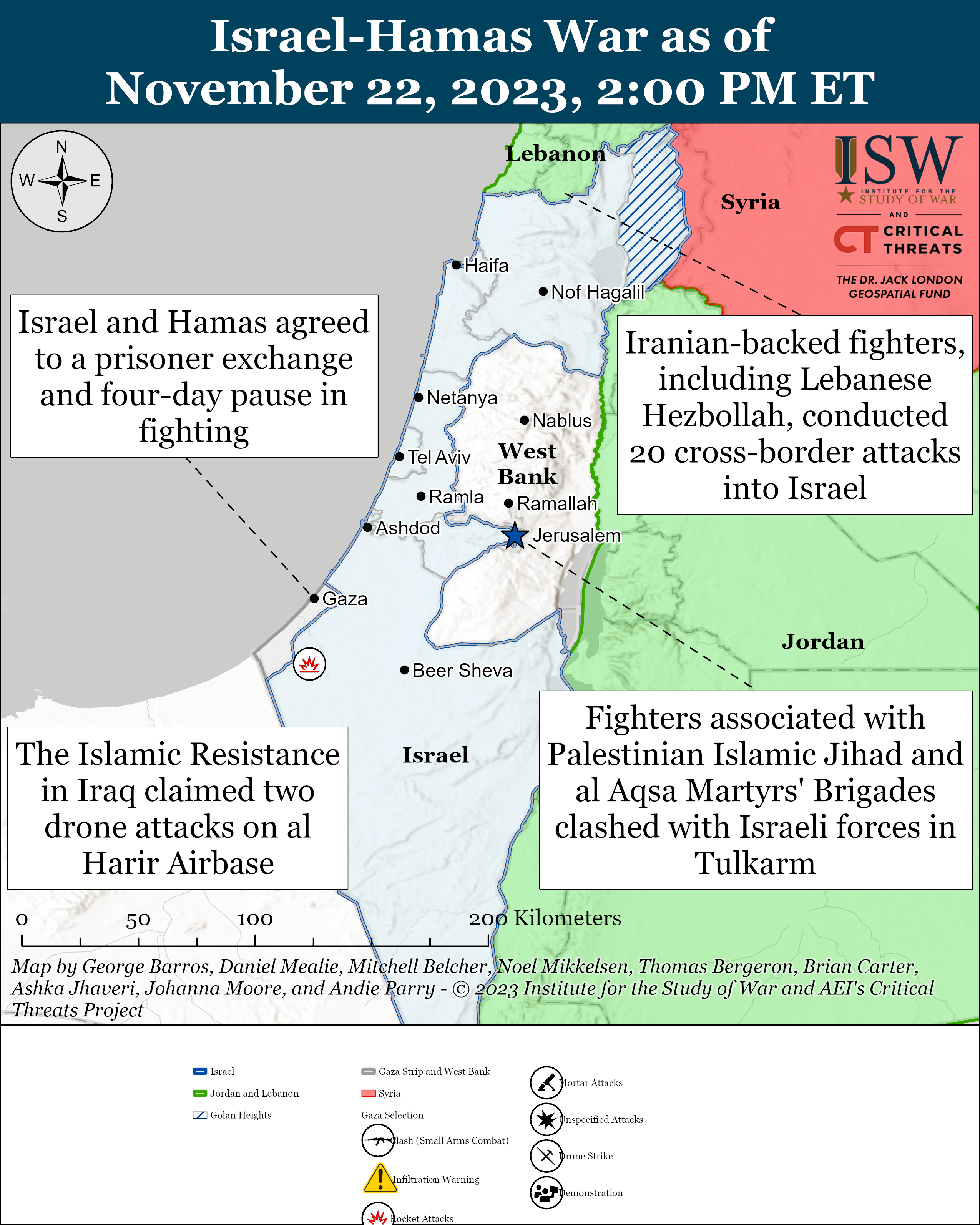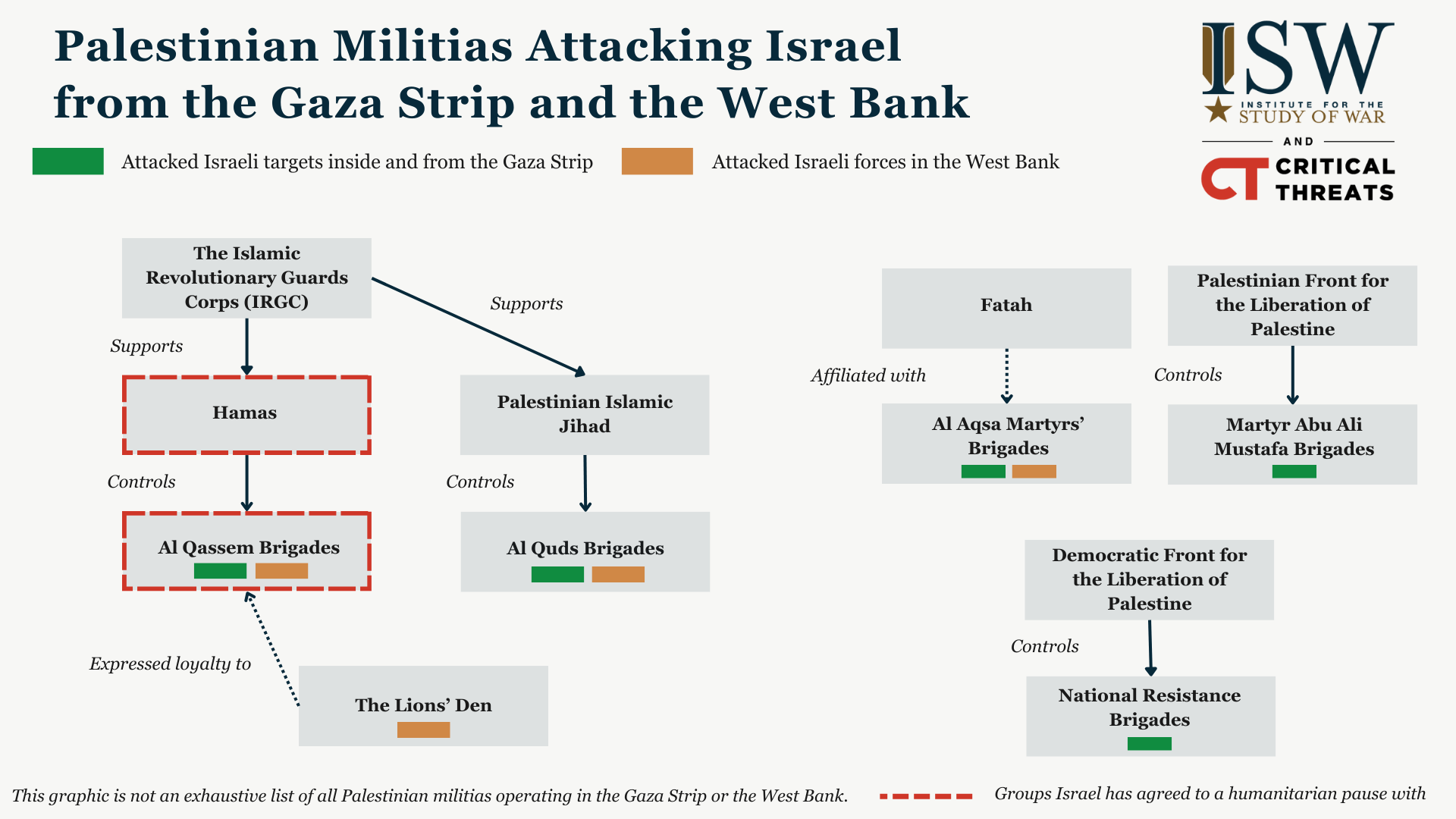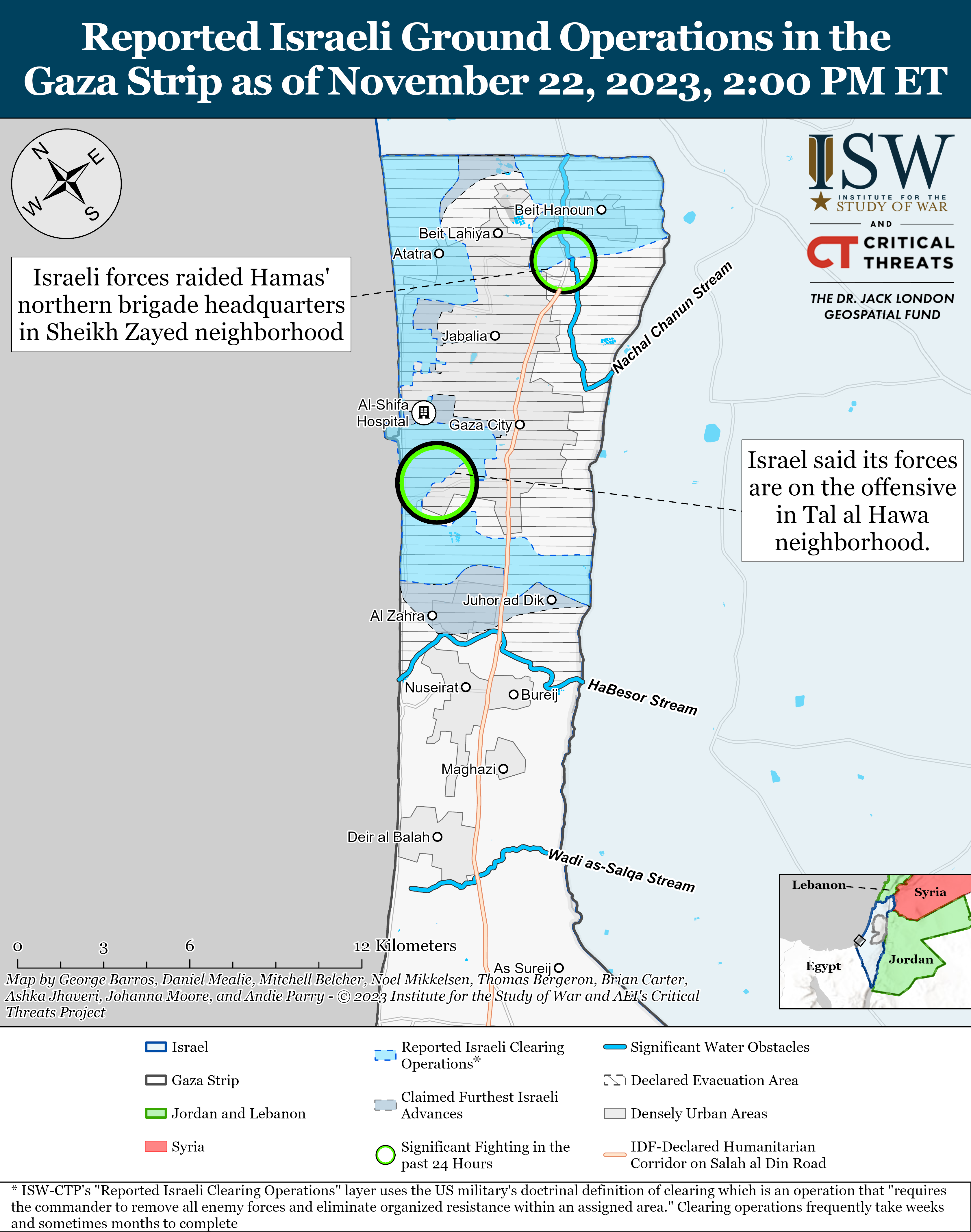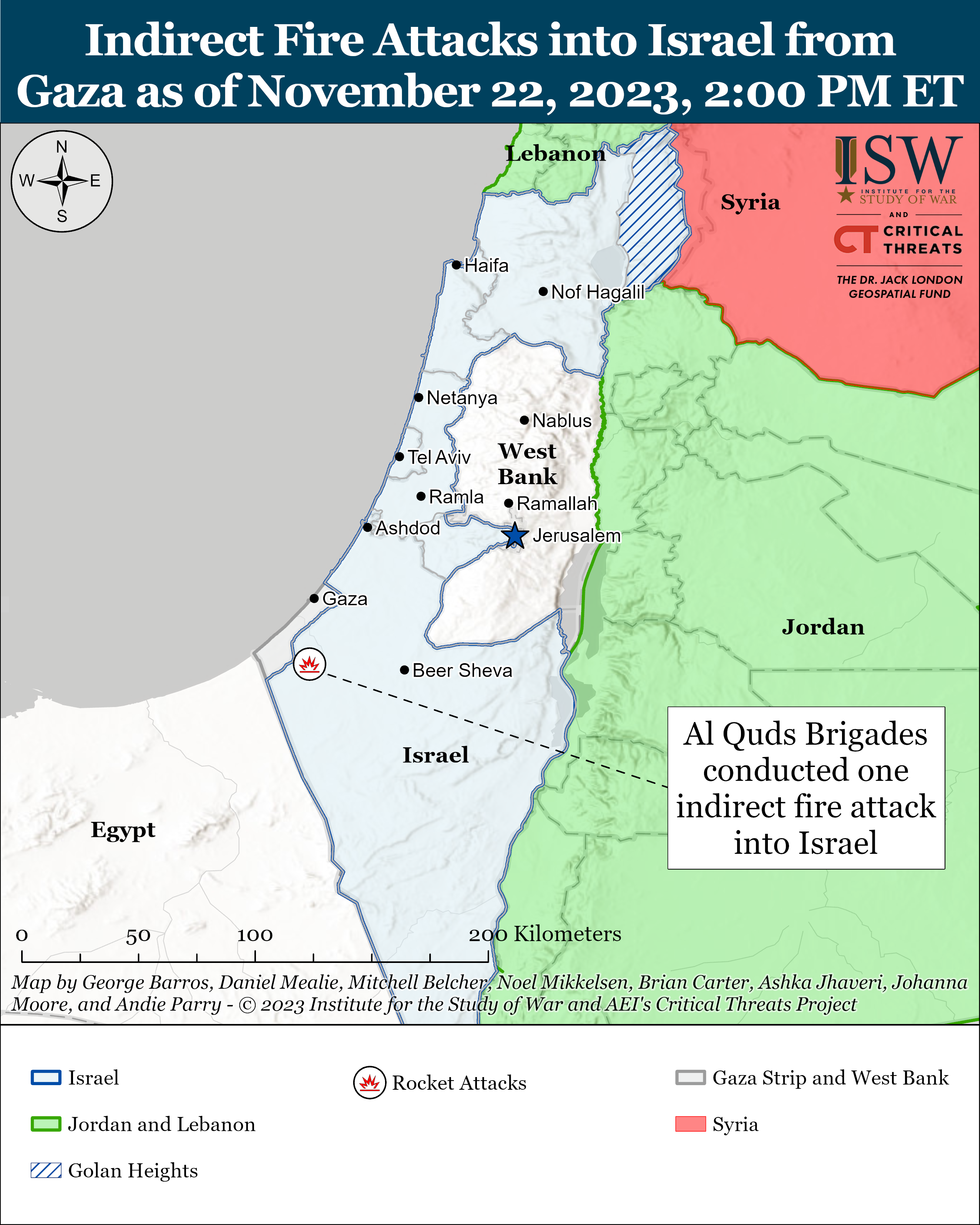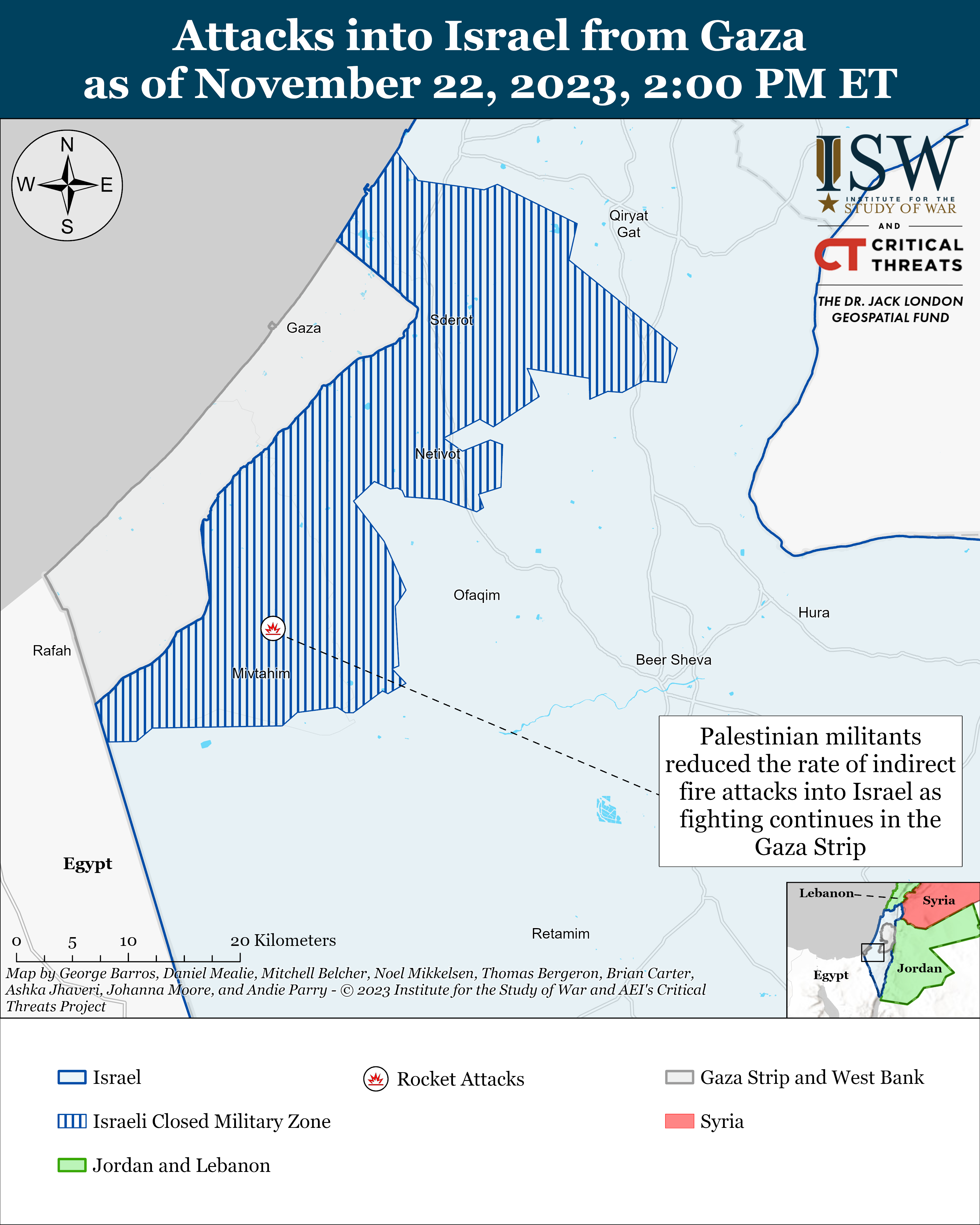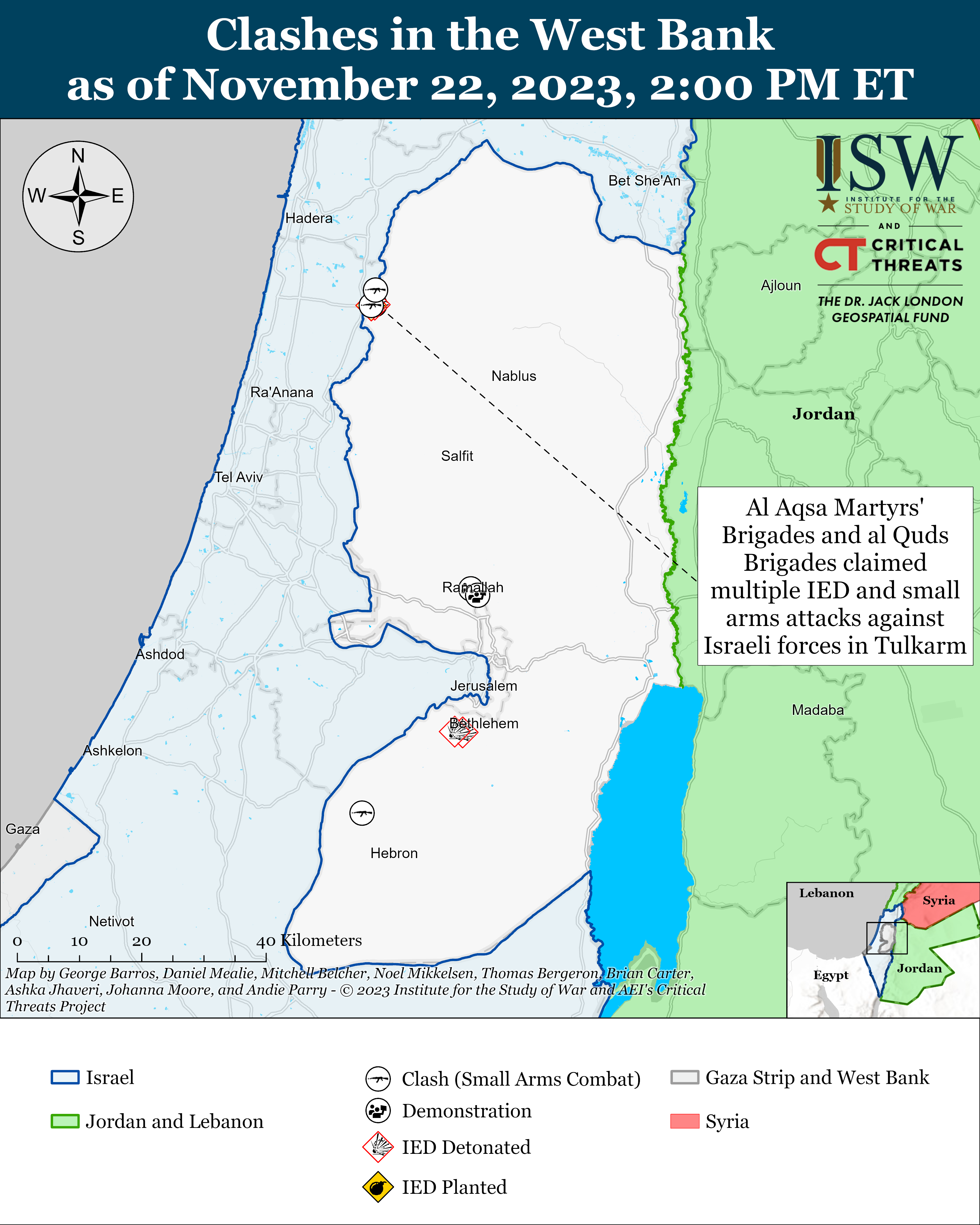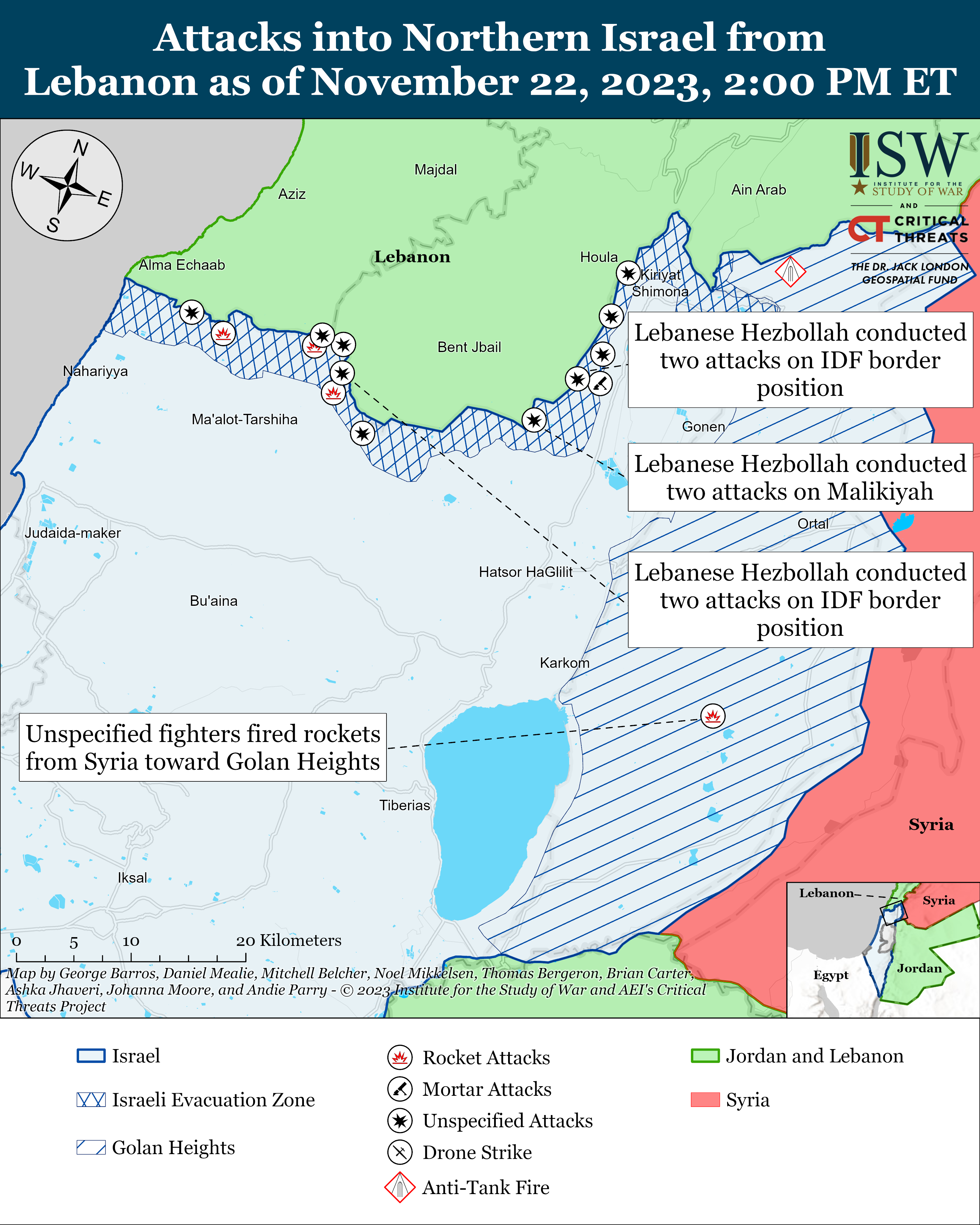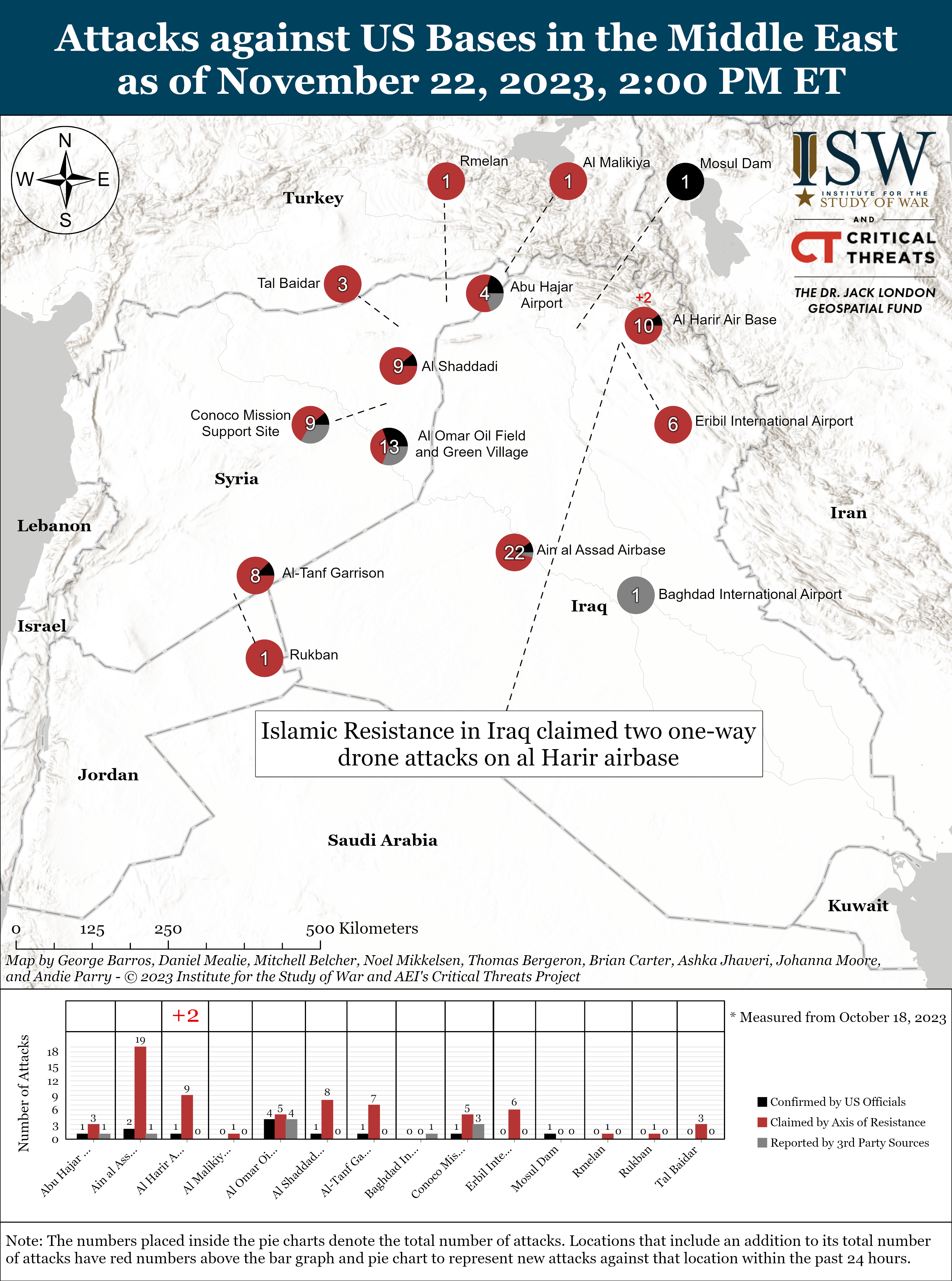 |
 |
Iran Update, November 22, 2023
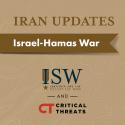
Iran Update, November 22, 2023
Andie Parry, Ashka Jhaveri, Johanna Moore, Peter Mills, and Annika Ganzeveld
Information Cutoff: 2:00 pm EST
The Iran Update provides insights into Iranian and Iranian-sponsored activities abroad that undermine regional stability and threaten US forces and interests. It also covers events and trends that affect the stability and decision-making of the Iranian regime. The Critical Threats Project (CTP) at the American Enterprise Institute and the Institute for the Study of War (ISW) provides these updates regularly based on regional events. For more on developments in Iran and the region, see our interactive map of Iran and the Middle East.
Note: CTP and ISW have refocused the update to cover the Israel-Hamas war. The new sections address developments in the Gaza Strip, the West Bank, Lebanon, and Syria, as well as noteworthy activity from Iran’s Axis of Resistance. We do not report in detail on war crimes because these activities are well-covered in Western media and do not directly affect the military operations we are assessing and forecasting. We utterly condemn violations of the laws of armed conflict and the Geneva Conventions and crimes against humanity even though we do not describe them in these reports.
Click here to see CTP and ISW’s interactive map of Israeli ground operations. This map is updated daily alongside the static maps present in this report.
CTP-ISW will not publish an update on Thursday, November 23, for the Thanksgiving holiday. CTP-ISW will resume publishing daily updates on Friday, November 24.
Key Takeaways:
- Israel and Hamas have agreed to a four-day humanitarian pause in fighting. Hamas is the only militant group explicitly mentioned in the humanitarian pause agreement.
- The entire Axis of Resistance has been involved in the escalation against the United States and Israel since October 7 and it is unclear how its non-Hamas members will react to the pause. Senior Iranian, Hamas, Lebanese, LH, and PIJ officials met in Beirut on November 22 to discuss the four-day humanitarian pause between Israel and Hamas.
- Iraq’s Popular Mobilization Forces (PMF)—an umbrella security organization that ostensibly reports to the Iraqi Prime Minister—held a funeral for five Kataib Hezbollah members who were killed in two US drone strikes on KH facilities on November 22. Iranian-backed militias attempted to portray the US airstrike as having targeted a state-affiliated security organization and not members of the US-designated Foreign Terrorist Organization, Kataib Hezbollah.
- The Islamic Resistance in Iraq claimed two drone attacks on al Harir Airbase in retaliation for Israeli operations in the Gaza Strip. The IDF intercepted a Houthi cruise missile that targeted Eilat, Israel on November 22.
- Israel published more evidence for how Hamas uses al Shifa Hospital as a command node.
Gaza Strip
Axis of Resistance campaign objectives:
- Erode the will of the Israeli political establishment and public to launch and sustain a major ground operation into the Gaza Strip
- Degrade IDF material and morale around the Gaza Strip
Israel and Hamas have agreed to a four-day humanitarian pause in fighting. Hamas official Mousa Abu Marzouk said the pause will begin at 0300 EST on Thursday, November 23. [1] The Israeli National Security Director said that hostages will not be released before Friday, however.[2] It is therefore unclear when the pause will begin. Statements from Israel and Hamas acknowledged a prisoner/hostage swap in return for a four-day pause in the fighting in the Gaza Strip with different levels of detail.[3] The Israeli government’s official statement said that 50 women and children would be released by Hamas over four days at a rate of at least 10 per day.[4] Hamas’ political wing issued a more detailed statement and said that it would release 50 Israeli women and children under the age of 19 in exchange for Israel releasing 150 Palestinian women and children under the age of 19. Israel’s statement presents the opportunity for the extension of the pause, stipulating that for each additional 10 hostages Hamas released, a day would be added to the pause. Hamas’ statement did not mention this aspect of the agreement.
Hamas’s statement also included details about a no-fly zone in the southern Gaza Strip, a partial no-fly zone in the northern Gaza Strip, and humanitarian, fuel, and medical aid deliveries. The official statement from Israel did not include details about these features of the deal. An anonymous senior Israeli security official speaking to the press said that Israel has alternatives to gathering intelligence via drone and that stormy days in the forecast would limit Israeli aerial intelligence gathering anyway.[5] This statement indicates that the no-fly zone is part of Israel’s understanding of the deal. Hamas also said that the parties agreed to “a ceasefire. . . and a cessation of all military actions by Israel in all areas of the Gaza Strip.” The Israeli statement did not specify where the fighting would stop or use the term “ceasefire.” The official Israeli statement mentioned only a “pause in the fighting.”
Hamas and Israel negotiated the pause with the mediation of Qatar, which released a separate statement affirming the agreement.[6] The Qatari statement included details about the release of 150 Palestinian prisoners from Israeli jails and humanitarian convoys carrying fuel entering the Gaza Strip.
Hamas said that it remains committed to the establishment of a Palestinian state with Jerusalem as its capital despite the truce and will remain the protective shield and defender of the Palestinian people until Israel is defeated. The Israeli government’s statement included the declaration that it will continue the war to eliminate Hamas.[7] Israeli Prime Minister Benjamin Netanyahu told the Knesset as it voted on the deal that Israeli security agencies assess that the war effort will not be harmed and that the deal will enable the IDF to prepare for the continuation of fighting.[8]
Hamas is the only militant group explicitly mentioned in the humanitarian pause agreement. Hamas is also the only Palestinian militant group that has acknowledged the pause agreement, despite the fact that Hamas is only one of several groups fighting Israeli forces in the Gaza Strip. Lebanese Hezbollah (LH) has unofficially indicated that it would adhere to a pause in fighting if Israel did, according to an unspecified LH official speaking to al Jazeera.[9] There are no indications that other Palestinian or Axis of Resistance groups regard themselves as bound by the Israel-Hamas agreement. Other Palestinian militant groups are actively fighting Israeli forces in the Gaza Strip and conducting indirect fire attacks into Israel. Palestinian Islamic Jihad (PIJ) attacked Israeli forces and launched rockets at Israel at least 15 times on November 21.[10] The al Aqsa Martyrs’ Brigade—a self-affiliated militant wing of Fatah—has conducted attacks on Israeli ground forces in the Gaza Strip and fired rockets into Israel.[11] The Popular Front for the Liberation of Palestine’s militant wing in the Gaza Strip—the Abu Ali Mustafa Brigades—has conducted at least 14 indirect fire attacks into Israel since the start of the war. The Democratic Front for the Liberation of Palestine’s militant wing has also conducted attacks from the Gaza Strip into Israel.[12]
PIJ’s and Hamas’ militant wings have acknowledged that they coordinate ground operations targeting Israeli forces in the Gaza Strip over the past several weeks of fighting.[13] PIJ and Hamas have also coordinated operations with other smaller militias in the Gaza Strip such as the al Nasser Salah al-Deen Brigades—the militant wing of Popular Resistance Committees.[14] Israel has repeatedly held Hamas responsible for all anti-Israel militant activity emanating from the Gaza Strip even as Hamas claims that it has no control over other militias operating in Gaza.[15] PIJ and possibly other militant groups are holding Israeli hostages, complicating hostage exchange according to Hamas, which has claimed that it does not control hostages held by other militias even though Hamas fighters were the ones who seized the hostages on October 7.[16] PIJ’s spokesperson Abu Hamza announced the death of one of its hostages, Hanna Katzir, on November 21.[17] These factors increase the risk that a non-Hamas militia that has nevertheless been coordinating military operations with Hamas could attack Israeli forces drawing an Israeli response that Hamas would attempt to frame as an Israeli violation of the agreement.
The entire Axis of Resistance has been involved in the escalation against the United States and Israel since October 7, and it is unclear how its non-Hamas members will react to the pause. Axis of Resistance groups, including the Houthis and the Islamic Resistance in Iraq—a coalition of Iranian-backed Iraqi militias, have continued to attack Israel while Israel and Hamas discuss the terms of the pause agreement. Houthi fighters hijacked an Israeli-owned, Japanese-operated freighter transiting the Red Sea on November 19 and launched a cruise missile at Eilat on November 22.[18] The Islamic Resistance in Iraq also began using close-range ballistic missiles against US forces in November, including on November 21.[19] It is unclear how this pattern will progress during the pause, as Hamas and Israel are the only combatant parties explicitly bound by the agreement.
Israel destroyed the headquarters of Hamas’ Northern Brigade in the Sheikh Zayed neighborhood during clearing operations. Israeli media reported that the IDF is expected to intensify combat operations in the Gaza Strip with a focus on clearing militant strongholds in the eastern Gaza Strip before there is a pause in fighting.[20] The IDF said on November 18 that it is expanding offensive operations toward Jabalia city in the northern Gaza Strip.[21] Israeli forces conducted targeted raids northwest of Jabalia in the Sheikh Zayed neighborhood on November 22, where Israel says several senior members of Hamas live.[22] The force located large tunnel shafts and large complexes and destroyed the headquarters of Hamas’ Northern Brigade.[23] The IDF said in a publication on November 13 that Hamas maintains five regional brigades, two of which operate in the northern Gaza Strip.[24] Israeli forces also discovered a model of an IDF vehicle.[25] Palestinian militias have made several claims to destroy Israeli vehicles and frequently target them with rocket-propelled grenades (RPG).
Israel said its forces are on the offensive in the Tal al Hawa neighborhood in southern Gaza city.[26] The IDF said its forces raided the Hamas Gaza City Brigades outpost and a military intelligence office where they discovered unspecified information about the underground infrastructure Hamas uses across the Gaza Strip.[27] Israeli forces also located a workshop for manufacturing drones and a laboratory for one-way attack drones, IEDs, mortars, and other weapons.[28]
The al Quds Brigades—the militant wing of Palestinian Islamic Jihad (PIJ)—said that its forces targeted Israeli forces against Israeli lines of advance. The al Quds Brigades claimed to attack Israeli forces advancing south of Gaza city and in neighborhoods surrounding Jabalia city with various munitions including RPGs, tandem-charge anti-tank weapons, small arms, and mortars.[29] The IDF has targeted PIJ operational headquarters since the Israel-Hamas war began.[30]
Israel published more evidence for how Hamas uses al Shifa Hospital as a command node. Israel posted footage of Hamas’ “underground city” and tunnel network underneath al Shifa Hospital on November 22.[31] Israeli forces discovered military equipment during clearing operations in the al Shifa Hospital area including various weapons and electronic devices, as well as patches of the al Quds Brigades.[32] CTP-ISW has reported that the IDF faces a loose coalition of Palestinian militant groups in the Gaza Strip—rather than just Hamas.
Palestinian militia fighters continued attacks targeting Israeli forces behind the Israeli forward line of advance, which is consistent with the nature of clearing operations. The al Qassem Brigades—the militant wing of Hamas—published several video compilations of various attacks it has conducted on Israeli forces across the northern Gaza Strip using RPGs, small arms, and IEDs.[33] The al Quds Brigades claimed to attack Israeli infantry forces in Beit Hanoun.[34]
Sources[35]
Recorded reports of rocket attacks; CTP-ISW cannot independently verify impact.
The al Quds Brigades conducted one indirect fire attack into Israel on November 22. The al Quds Brigades fired rockets at the Third Eye military site in southern Israel.[36] The al Qassem Brigades did not claim indirect fire attacks into Israel on November 22.
Recorded reports of rocket attacks; CTP-ISW cannot independently verify impact.
West Bank
Axis of Resistance campaign objectives:
- Draw IDF assets and resources toward the West Bank and fix them there
Palestinian militia fighters conducted 18 attacks on Israeli forces, primarily in Tulkarm, in the West Bank on November 22. Unspecified Palestinian militia fighters fired small arms at Israeli forces and detonated at least five IEDs targeting them on November 22 in response to an Israeli raid in Tulkarm.[37] The al Aqsa Martyrs’ Brigade’ Tulkarm Rapid Response Battalion acknowledged six of its fighters, including four commanders, died during the Israeli operation in Tulkarm.[38] The al Quds Brigades stated that it participated in the fighting against Israeli forces in Tulkarm, but did not acknowledge any casualties.[39] Unspecified fighters engaged in five small arms clashes and detonated at least two IEDs targeting Israeli forces across the West Bank on November 22.[40] The IDF reported Israel arrested 29 people, of whom 3 were associated with Hamas, across the West Bank.[41]
CTP-ISW recorded two demonstrations in Ramallah in the West Bank on November 22.[42] One of the demonstrations took place outside the German consulate to protest Germany’s support for Israel’s campaign in the Gaza Strip.[43]
This map is not an exhaustive depiction of clashes and demonstrations in the West Bank.
Southern Lebanon and Golan Heights
Axis of Resistance campaign objectives:
- Draw IDF assets and resources toward northern Israel and fix them there
- Set conditions for successive campaigns into northern Israel
Iranian-backed fighters, including LH, conducted 20 attacks on November 22 into Israeli territory from Lebanon. LH specifically claimed 16 attacks on Israeli border positions.[44] Unspecified fighters separately launched three rocket salvoes and sent one unspecified drone into northern Israel.[45] The IDF conducted multiple airstrikes targeting LH units conducting cross-border attacks and LH military infrastructure in southern Lebanon.[46]
Unspecified fighters in Syria fired rockets toward the Golan Heights on November 22 after the IDF carried out an airstrike targeting possible Iranian-backed fighters in Sayyida Zainab, Damascus.[47] Iranian-backed militia groups have long maintained bases in Sayyida Zainab and used it to facilitate Iranian lines of effort elsewhere in Syria.[48]
Iran and Axis of Resistance
Axis of Resistance campaign objectives:
- Demonstrate the capability and willingness of Iran and the Axis of Resistance to escalate against the United States and Israel on multiple fronts
- Set conditions to fight a regional war on multiple fronts
Iraq’s Popular Mobilization Forces (PMF)—an umbrella security organization that ostensibly reports to the Iraqi prime minister—held a funeral for five Kataib Hezbollah (KH) members, who were killed in two US drone strikes on KH facilities on November 22.[49] Iranian-backed militias Ashab al Kahf and Harakat Hezbollah al Nujaba offered condolences and congratulations to KH for the death and martyrdom of their militants.[50] The PMF-sponsored funeral, however, highlighted the militants’ affiliation with the PMF and referred to them as martyrs of the PMF.[51] The PMF funeral procession showed portraits of the killed KH militants alongside PMF insignia.[52] In doing so, Iranian-backed militias attempted to portray the US airstrike as having targeted a state-affiliated security organization and not members of the US-designated Foreign Terrorist Organization (FTO), KH.
Two unidentified defense officials reported that US fighter jets struck a KH operations center and KH command and control center in Jurf al Saqr, Babil Province, Iraq, on November 22 and confirmed that KH personnel were located at both facilities.[53] KH has retained control of Jurf al Saqr since 2021 following their forces' relocation of local Sunnis from the area from late 2020 to early 2021.[54] Iranian-backed militias expanded their presence within the Baghdad Belts in 2020 under the pretext of counter-ISIS operations following the US force drawdown.[55] However, during that time, ISIS was conducting targeted attacks in Jurf al Saqr to stoke ethnic conflict. Iranian-backed militias, namely KH, fed into the ISIS objective by forcibly displacing Sunnis from the area.[56] KH has prevented Sunnis from returning and has effectively blocked Iraqi security forces from operating in the area to mask their activities from the Iraqi government as ISW previously reported.[57]
The Islamic Resistance in Iraq claimed two drone attacks on al Harir Airbase in retaliation for Israeli operations in the Gaza Strip.[58] The Islamic Resistance in Iraq has claimed 11 attacks on US forces stationed at al Harir Airbase since October 18.[59]
The IDF intercepted a Houthi cruise missile that targeted Eilat, Israel on November 22.[60] The IDF reported that one of its F-35 fighter jets intercepted a cruise missile over the Red Sea.[61] The Houthi Movement claimed the attack on Eilat in support of Palestinian militias fighting in the Gaza Strip.[62] The Houthis have claimed five drone and surface-to-surface missile attacks targeting Eilat since October 18.[63] The Houthi movement threatened on October 31 to ”continue its strikes with rockets and drones until the Israeli aggression [in the Gaza Strip] stops.”[64]
Senior Iranian, Hamas, Lebanese, LH, and PIJ officials met in Beirut on November 22 to discuss the four-day humanitarian pause between Israel and Hamas. Iranian Foreign Affairs Minister Hossein Amir Abdollahian met with the Deputy Chairman of Hamas’ Political Bureau in the Gaza Strip, Khalil al Haya, PIJ Secretary General Ziyad al Nakhalah, and Lebanese Parliament Speaker Nabih Berri.[65] Abdollahian discussed the four-day humanitarian pause in his meetings with these officials and Iranian Foreign Affairs Ministry spokesperson Nasser Kanani told Iranian state media on November 22 that Abdollahian had traveled to Beirut to “help stabilize the ceasefire.”[66] LH-affiliated media reported that Abdollahian will also meet with LH Secretary General Hassan Nasrallah.[67] Abdollahian’s visit to Beirut notably coincides with Nasrallah’s meeting with Haya and Hamas senior representative to Lebanon Osama Hamdan on November 22.[68] Abdollahian’s November 22 visit to Beirut marks his second trip to Lebanon since the start of the Israel-Hamas war on October 7. Abdollahian last traveled to Beirut on October 12 as part of his regional diplomatic tour to Iraq, Lebanon, Syria, and Qatar, as CTP-ISW previously reported.[69]
Iranian Supreme Leader Ali Khamenei discussed the Israel-Hamas war with a group of Iranian athletes in Tehran on November 22.[70] Khamenei warned that Israel’s “atrocities” will not go “unanswered” and that Israel’s attacks on the Gaza Strip will “shorten [Israel’s] lifespan.” Khamenei has used similarly threatening language in his speeches since October 7. He warned on October 17, for example, that the continuation of Israeli “crimes” against Palestinians in the Gaza Strip will make resistance groups “impatient” and that “no one will be able to stop [these groups].”[71]
Iranian President Ebrahim Raisi conducted an interview with five Axis of Resistance media outlets on November 22.[72] Raisi’s interview is noteworthy given that Iranian officials typically do not conduct interviews with numerous outlets simultaneously. Raisi conducted the interview with LH-affiliated al Manar, Kataib Hezbollah-operated al Etejah, PIJ-affiliated Filastin al Yawm, Hamas-controlled Al Aqsa TV, and Houthi-controlled al Masirah. Raisi claimed that Israel’s “insults” to the Al Aqsa Mosque and “killing” of Palestinians before October 7 precipitated the Al Aqsa Flood Operation. Raisi further claimed that the IDF has thus far failed to eliminate Hamas in the Gaza Strip and that the United States opposes a ceasefire because it fears a ceasefire “will make Israel’s defeat certain”[73]
[1] https://twitter.com/manniefabian/status/1727276905672638863
[2] https://www.axios.com/2023/11/22/israel-hamas-hostage-deal-timeline-palestinian-prisoners; https://twitter.com/JoeTruzman/status/1727447622389215236
[3] https://www.gov.il/en/departments/news/spoke-kidnapped221123 ; https://t.me/hamasps/17906
[4] https://www.gov.il/en/departments/news/spoke-kidnapped221123
[5] https://twitter.com/Doron_Kadosh/status/1727209726067544215
[6] https://twitter.com/majedalansari/status/1727235402770059534
[7] https://www.gov.il/en/departments/news/spoke-kidnapped221123
[8] https://www.gov.il/en/departments/news/spoke-joint211123
[9] https://www.newarab.com/news/hezbollah-says-it-will-abide-israel-hamas-ceasefire
[10] https://t.me/sarayaps/16736 ; https://t.me/sarayaps/16732 ; https://t.me/sarayaps/16731 ; https://t.me/sarayaps/16730 ; https://t.me/sarayaps/16728 ; https://t.me/sarayaps/16727 ; https://t.me/sarayaps/16726 ; https://t.me/sarayaps/16725 ; https://t.me/sarayaps/16724 ; https://t.me/sarayaps/16723 ; https://t.me/sarayaps/16722 ; https://t.me/sarayaps/16721
[11] https://t.me/AymanGouda/5801 ; https://t.me/AymanGouda/5841 ; https://t.me/AymanGouda/5795
[12] https://t.me/QudsN/312785 ; https://twitter.com/AlMayadeenNews/status/1714983570710687932 ; https://t.me/QudsN/316038
[13] https://t.me/sarayaps/16707
[14] https://t.me/sarayaps/16679
[15] https://twitter.com/IDF/status/1082140811041665024 ; https://www.lemonde.fr/en/international/article/2022/08/10/unlike-hamas-islamic-jihad-has-no-desire-to-exercise-political-power_5993159_4.html
[16] https://www.cbsnews.com/news/negotiators-near-hamas-deal-to-release-hostages-israel-qatar/
[17] https://t.me/abuhamzasaraya/84
[18] https://www.reuters.com/video/watch/idsIZC?now=true ; https://twitter.com/idfonline/status/1727333155273932995
[19] https://twitter.com/CENTCOM/status/1727124401056092540
[20] https://twitter.com/IsraelRadar_com/status/1727372027064139830
[21] https://twitter.com/AvichayAdraee/status/1725890537520091244
[22] https://twitter.com/idfonline/status/1727225022715245029; https://twitter.com/idfonline/status/1727334436390223921; https://twitter.com/AvichayAdraee/status/1727341141874405571
[23] https://twitter.com/idfonline/status/1727225022715245029; https://twitter.com/idfonline/status/1727334436390223921; https://twitter.com/AvichayAdraee/status/1727341141874405571
[24] https://idf dot il/150310
[25] https://twitter.com/idfonline/status/1727225022715245029; https://twitter.com/idfonline/status/1727334436390223921; https://twitter.com/AvichayAdraee/status/1727341141874405571
[26] https://twitter.com/idfonline/status/1727367699590738003
[27] https://twitter.com/idfonline/status/1727367699590738003
[28] https://twitter.com/idfonline/status/1727367699590738003
[29] https://t.me/sarayaps/16740
[30] https://twitter.com/idfonline/status/1711304715223384446
[31] https://twitter.com/IDF/status/1727409278636478519
[32] https://twitter.com/IDF/status/1727387582378688562
[33] https://t.me/qassam1brigades/517; https://t.me/qassam1brigades/516; https://twitter.com/MayadeenEnglish/status/1727381447005126950
[34] https://t.me/sarayaps/16732
[35] https://www.washingtoninstitute.org/policy-analysis/how-iran-fuels-hamas-terrorism; https://jiss.org.il/en/mansharof-the-relationship-between-iran-and-palestinian-islamic-jihad/; https://t.me/qassambrigades/29209; https://t.me/sarayaps/16716; https://t.me/QudsN/322059; https://twitter.com/SafaPs/status/1719698310913462778; https://t.me/QudsN/322081; https://t.me/kataebabuali/10458; https://t.me/mihwar_almuqawama/38089; https://www.cfr.org/backgrounder/al-aqsa-martyrs-brigade; https://t.me/areennabluss/291
[36] https://t.me/sarayaps/16738
[37] https://t.me/alredalsrey/468 ; https://t.me/alredalsrey/470 ; https://t.me/sarayatulkarm/417 ; https://t.me/sarayatulkarm/418 ; https://twitter.com/idfonline/status/1727294953959956769
[38] https://t.me/s/alredalsrey ; https://t.me/s/kataipshohdaaalaqsa
[39] https://t.me/s/sarayatulkarm
[40] https://twitter.com/idfonline/status/1727294953959956769 ; https://t.me/QudsN/333139 ; https://t.me/QudsN/333177 ; https://t.me/QudsN/333222 ; https://t.me/QudsN/333209 ; https://t.me/QudsN/333208
[41] https://www.idf dot il/154824
[42] https://t.me/QudsN/333262 ; https://t.me/QudsN/333276
[43] https://t.me/QudsN/333262
[44] https://t.me/C_Military1/40059 ; https://t.me/C_Military1/40077 ; https://t.me/QudsN/333141 ; https://t.me/C_Military1/40081 ; https://t.me/C_Military1/40090 ; https://t.me/C_Military1/40093 ; https://t.me/C_Military1/40088 ; https://twitter.com/GLZRadio/status/1727326370068377665 ; https://t.me/C_Military1/40108 ; https://t.me/C_Military1/40109 ; https://t.me/C_Military1/40111 ; https://t.me/C_Military1/40114 ; https://t.me/C_Military1/40118 ; https://t.me/QudsN/333256
[45] https://twitter.com/idfonline/status/1727089505923186776 ; https://t.me/C_Military1/40075 ; https://twitter.com/GLZRadio/status/1727326792178864150 ; https://twitter.com/idfonline/status/1727089507705741671
[46] https://twitter.com/manniefabian/status/1727250593100804509 ; https://twitter.com/GLZRadio/status/1727376032465145874
[47] https://twitter.com/QalaatAlMudiq/status/1727391193099620700 ; https://twitter.com/Archer83Able/status/1727310051860230426 ; https://twitter.com/QalaatAlMudiq/status/1727394090827018692
[48] https://www.atlanticcouncil.org/blogs/menasource/factbox-iranian-influence-and-presence-in-syria/ ; https://ctc.westpoint.edu/from-karbala-to-sayyida-zaynab-iraqi-fighters-in-syrias-shia-militias/ ; https://www.theguardian.com/world/2017/jan/13/irans-syria-project-pushing-population-shifts-to-increase-influence ; https://www.mei.edu/publications/israels-response-iran-syria-choosing-between-escalation-and-accommodation-0
[49] https://apnews.com/article/israel-iraq-airstrike-military-iran-d93d861feeef90cfeac3ba85f1f2f36d ; https://t.me/teamsmediawar_1/94597 ; https://t.me/teamsmediawar_1/94596
[50] https://t.me/aishab_alkahf/109 ; https://t.me/Tura313/46465
[51] https://t.me/teamsmediawar_1/94596 ; https://t.me/teamsmediawar_1/94597
[52] https://t.me/QudsN/333180 ; https://t.me/teamsmediawar_1/94586 ; https://t.me/teamsmediawar_1/94596 ; https://t.me/teamsmediawar_1/94597
[53] https://apnews.com/article/israel-iraq-airstrike-military-iran-d93d861feeef90cfeac3ba85f1f2f36d ; https://t.me/teamsmediawar_1/94597 ; https://t.me/teamsmediawar_1/94596
[54] https://www.understandingwar.org/backgrounder/isis-and-iranian-backed-militias-compete-control-baghdad-region
[55] https://www.understandingwar.org/backgrounder/isis-and-iranian-backed-militias-compete-control-baghdad-region
[56] https://www.understandingwar.org/backgrounder/isis-and-iranian-backed-militias-compete-control-baghdad-region
[57] https://www.understandingwar.org/backgrounder/isis-and-iranian-backed-militias-compete-control-baghdad-region
[58] https://t.me/elamharbi/126 ; https://t.me/elamharbi/125
[59] https://t.me/elamharbi/3 ; https://t.me/elamharbi/10 ; https://t.me/elamharbi/14 ; https://t.me/elamharbi/70 ; https://t.me/elamharbi/79 ; https://t.me/elamharbi/87 ; https://t.me/elamharbi/87 ; https://t.me/elamharbi/90 ; https://t.me/elamharbi/103 ; https://t.me/elamharbi/109 ; https://t.me/elamharbi/125 ; https://t.me/elamharbi/126
[60] https://www.timesofisrael dot com/idf-says-it-shot-down-cruise-missile-apparently-fired-by-houthis-over-red-sea/
[61] https://www.timesofisrael dot com/idf-says-it-shot-down-cruise-missile-apparently-fired-by-houthis-over-red-sea/
[62] https://www.ansarollah dot com/archives/644391
[63] https://www.timesofisrael dot com/in-first-arrow-system-used-to-down-missile-from-red-sea-houthis-claim-uav-attack/ ; https://apnews.com/article/israel-palestinians-hamas-war-yemen-houthis-iran-34eab8bc1d3cf3606d874166fef2f018 ; https://www.timesofisrael dot com/in-first-arrow-system-used-to-down-missile-from-red-sea-houthis-claim-uav-attack/ ; https://apnews.com/article/israel-palestinians-hamas-war-yemen-houthis-iran-34eab8bc1d3cf3606d874166fef2f018 ; https://twitter.com/army21ye/status/1719808498416927049 ; https://twitter.com/army21ye/status/1721592644944494911 ; https://twitter.com/manniefabian/status/1722672932776710281
[64] https://twitter.com/army21ye/status/1719340968812425410 ; https://twitter.com/army21ye/status/1719345629208412584
[65] https://www.farsnews dot ir/news/14020901000933 ;
https://www.irna dot ir/news/85300153 ;
https://www.tasnimnews dot com/fa/news/1402/09/01/2994016 ;
https://www.farsnews dot ir/news/14020901000833
[66] https://www.tasnimnews dot com/fa/news/1402/09/01/2993909
[67] https://www.farsnews dot ir/news/14020901000684
[68] https://t.me/C_Military1/40064
[69] https://mfa dot ir/portal/newsview/731370 ;
https://www.criticalthreats.org/analysis/iran-update-october-13-2023
[70] https://www.leader dot ir/fa/content/26790
[71] https://www.leader dot ir/fa/content/26718
[72] https://www.irna dot ir/news/85300354
[73] https://donya-e-eqtesad dot com/%D8%A8%D8%AE%D8%B4-%D8%B3%D8%A7%DB%8C%D8%AA-%D8%AE%D9%88%D8%A7%D9%86-62/4022831-%D8%B1%D8%A6%DB%8C%D8%B3%DB%8C-%D8%A7%D8%B3%D8%B1%D8%A7%D8%A6%DB%8C%D9%84-%D8%AA%D8%A7-%D8%A8%D9%87-%D8%A7%D9%85%D8%B1%D9%88%D8%B2-%D9%85%D9%88%D9%81%D9%82%DB%8C%D8%AA%DB%8C-%D9%86%D8%AF%D8%A7%D8%B4%D8%AA%D9%87-%D8%A7%D8%B3%D8%AA-%D9%82%D8%AA%D9%84-%D8%B9%D8%A7%D9%85-%D8%B2%D9%86%D8%A7%D9%86-%DA%A9%D9%88%D8%AF%DA%A9%D8%A7%D9%86-%D9%BE%DB%8C%D8%B1%D9%88%D8%B2%DB%8C-%D9%86%DB%8C%D8%B3%D8%AA
